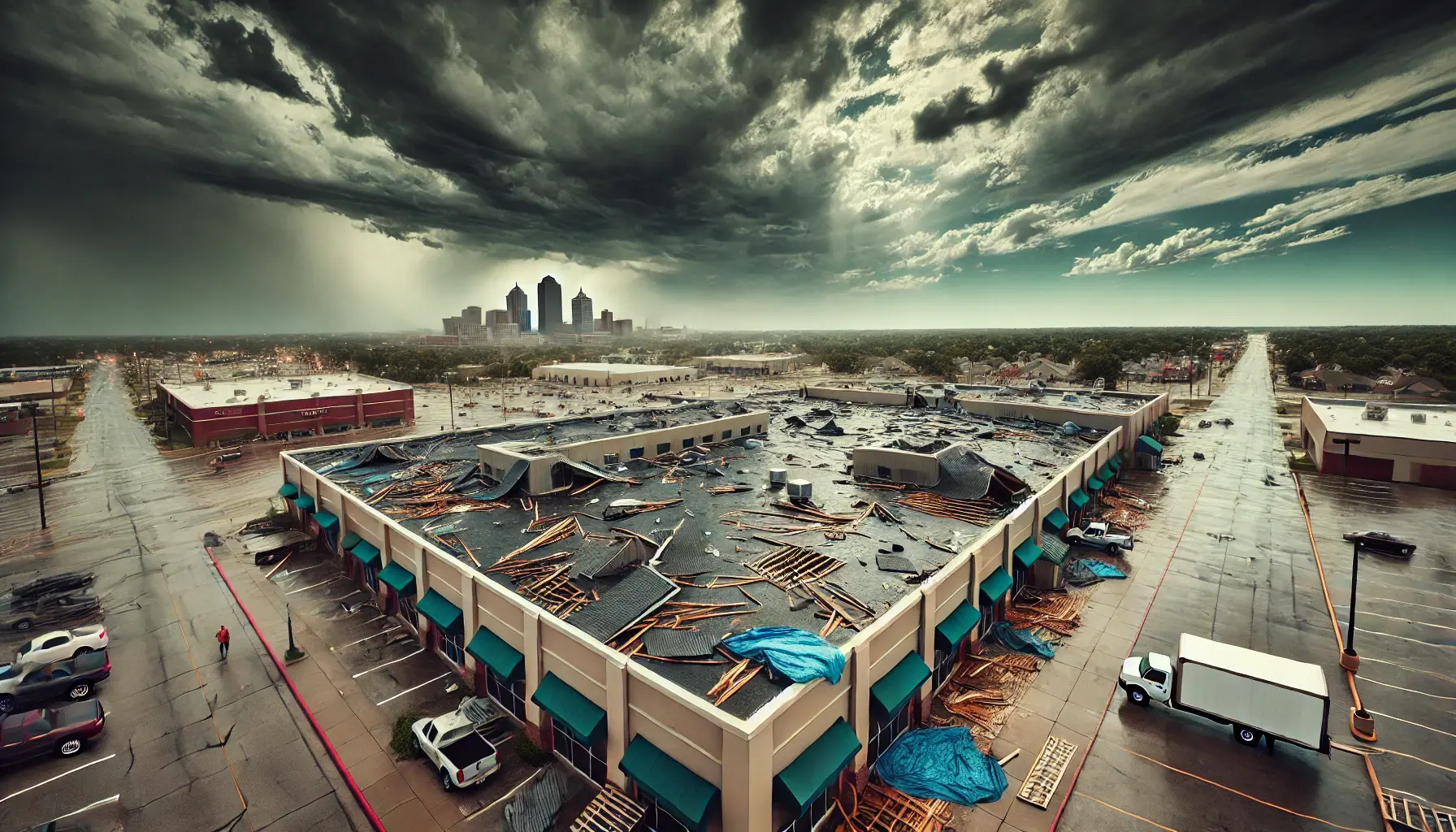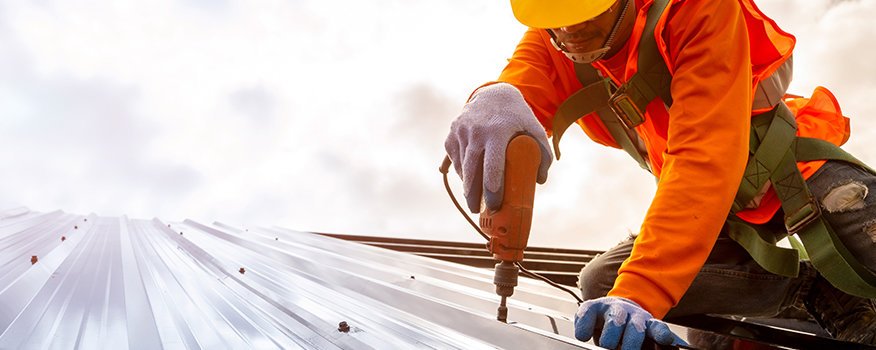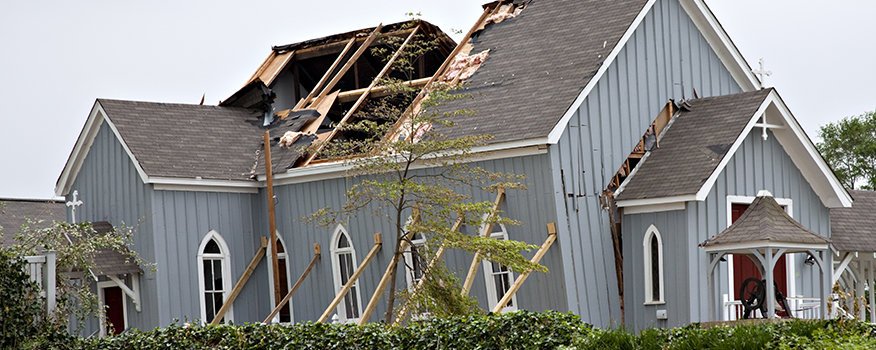Wichita’s unpredictable weather can quickly shift from calm to chaotic, leaving commercial property owners facing the aftermath of severe storms. These storms, which may bring high winds, heavy rain, and damaging hail, often target your building’s first line of defense—its roof. Immediate action is crucial to prevent minor issues from escalating into costly, long-term damage.
This guide provides clear, actionable steps to take after storm damage occurs, helping you safeguard your property. We’ll walk through safe damage assessment, how to document for insurance claims, and why professional repair is essential for long-term protection.
If your commercial roof has been impacted by a recent storm, Solid Rock Commercial Roofing is here to help with fast, professional inspections and repairs. Here’s what you need to know to take immediate action and protect your building.
Key Takeaways from “Immediate Steps to Take for Storm Damage Roof Repair in Wichita”
- Safety First: Always prioritize safety when assessing storm damage. Perform a visual inspection from the ground and look for interior signs of damage, such as water stains or peeling paint.
- Document the Damage: Thorough documentation (photos, videos, notes) is critical for insurance claims. Record the type of storm, damage, and any immediate issues to streamline the process.
- Temporary Measures: Protect your roof from further damage with temporary fixes, such as tarping exposed areas and clearing debris from gutters, while waiting for professional help.
- Call a Professional Contractor: Promptly contact a professional roofing contractor, like Solid Rock Commercial Roofing, for a thorough inspection and repair. Avoid DIY repairs to prevent voiding warranties or worsening the damage.
- Different Types of Storm Damage: Understand the various types of damage caused by hail, wind, rain, and debris. Each type requires specific inspection and repair techniques.
- Professional Roof Inspection: Expect a professional roofing inspection to include a thorough surface check, underlayment assessment, moisture detection, and repair recommendations.
- Preventative Measures: Regular maintenance, roof coatings, and reinforcing vulnerable areas can help protect your roof from future storm damage and extend its lifespan.
- Call to Action: If you’ve experienced storm damage, contact Solid Rock Commercial Roofing for a free inspection and fast, reliable repairs to protect your commercial property.
1. Assess the Damage Safely
After a storm, it’s natural to want to check for damage, but your safety should always come first. Climbing onto the roof without proper training can be dangerous. Instead, start by assessing the damage from the ground.
Visual Inspection from Ground Level
Walk around the perimeter of your building and look for obvious signs of damage. Missing shingles, fallen debris, or areas that appear sagging could indicate roof damage. Check for any shingles or roofing material scattered in the yard or parking lot, which can be an early warning of more severe issues above.
Example: After a Wichita hailstorm, John, a local warehouse owner, noticed pieces of roofing material scattered across his property. While the damage wasn’t immediately visible on the roof, these signs led him to schedule an inspection to avoid further issues.
Signs of Interior Damage
Sometimes the impact of storm damage isn’t obvious from the outside. Water intrusion may show up inside the building as stains on ceilings, peeling paint, or musty odors. These could be indicators of a leaky roof. Be sure to check inside for damp areas or discoloration on the walls and ceiling. If you find any of these, it’s crucial to take action quickly before mold sets in.
Why Immediate Assessment Matters
Delaying an inspection can lead to even greater problems. A small leak today could turn into a major issue if left unaddressed. Water damage can weaken structural components, encourage mold growth, and lead to expensive repairs.
By addressing problems early, you prevent minor damage from escalating. John’s decision to inspect and repair his roof after noticing the scattered shingles helped him avoid a costly roof replacement down the road.
2. Document the Damage for Insurance Purposes
Once you’ve safely assessed the damage, the next step is to document everything. Proper documentation not only helps you stay organized but also strengthens your insurance claim.
Take Photos and Videos
Be sure to photograph or record the roof and any visible damage. Take clear shots from multiple angles to capture the full extent of the damage, both inside and outside the building. Don’t forget to take close-up shots of specific problem areas, like missing shingles, dents, or cracks.
Keep Detailed Records
It’s also important to document the storm itself. Note the date, time, and type of storm (hail, wind, heavy rain). If there are any immediate issues, like active leaks or electrical problems, make a note of those too. These details will help your insurance company process your claim more quickly.
Working with Your Insurance Company
Contact your insurance provider to begin the claims process as soon as possible. Providing comprehensive documentation will make the process smoother. Partnering with Solid Rock Commercial Roofing can also streamline this step—we can assist with detailed assessments and provide the necessary reports for your claim.
Example: When “ABC Enterprises” suffered roof damage from hail, they worked closely with Solid Rock. Our team’s thorough documentation helped expedite their insurance claim and ensured that repairs were approved quickly.
3. Temporary Fixes While Waiting for Professional Help
Storms can affect large areas, meaning it might take time for a roofing professional to arrive. In the meantime, you can take some simple steps to protect your building from further damage.
Cover Damaged Areas with Tarps
If parts of your roof are exposed, cover them with heavy-duty tarps to prevent rain from seeping in. Secure the tarp with ropes or bungee cords—avoid nails or staples, as they can cause further damage.
Clear Debris from Gutters and Roof Surface
Removing storm debris from the roof, gutters, and drains helps prevent water from pooling and causing additional damage. However, if the roof isn’t stable or safe, don’t attempt to clear debris yourself—leave this task to professionals.
Avoid DIY Repairs
Resist the urge to fix the damage yourself beyond these temporary measures. Inexperienced repairs can void warranties or worsen the situation. It’s always best to wait for a professional assessment and repair.
Example: A business owner who attempted a quick DIY patch job on his roof ended up trapping water beneath the surface, which led to structural issues. A professional would have used the correct materials and methods to resolve the problem properly.
4. Call a Professional Roofing Contractor (Solid Rock Commercial Roofing)
Once you’ve taken temporary measures, it’s time to contact a professional roofing contractor. Attempting to repair a storm-damaged roof yourself is not only risky but could also lead to more significant problems down the line.
Why Choose a Local, Experienced Roofing Contractor?
Hiring a local contractor like Solid Rock ensures that you’re working with a company that understands Wichita’s weather patterns, building codes, and the specific challenges of commercial roofing. With years of experience in the region, Solid Rock can provide the personalized service and expertise needed to restore your roof efficiently.
Expertise with Commercial Roofs
Different commercial roofing systems—such as flat roofs, metal, TPO, or modified bitumen—require specialized knowledge for effective repairs. Solid Rock Commercial Roofing has the experience to address all types of commercial roofs, ensuring that repairs are durable and correctly applied.
24/7 Emergency Services
At Solid Rock, we know that storm damage doesn’t wait for business hours. That’s why we offer 24/7 emergency services to help you protect your building as soon as a storm passes. Whether it’s midnight or the weekend, our team is ready to respond and begin repairs.
Example: A local business contacted Solid Rock in the middle of the night after a storm tore off part of their roof. Our team was able to tarp the exposed areas quickly and start repairs the next morning, preventing water damage to their valuable inventory.
5. Understanding Different Types of Storm Damage
Each storm brings its own set of challenges, and the damage left behind can vary based on the type of weather event. Here’s a breakdown of the most common types of storm damage and what to watch for:
Hail Damage
Hailstorms can cause visible dents in metal roofs or crack and puncture shingles, leading to long-term issues like leaks. Even small hailstones can weaken roofing materials over time, making repairs crucial after a storm.
Wind Damage
High winds can rip off shingles, loosen roof components, or even peel back sections of a flat roof. Pay attention to any loose or missing roofing materials, as wind damage often leaves your roof exposed to further problems.
Water Damage
Heavy rains can cause pooling on flat roofs or seep into small cracks. Over time, water accumulation can lead to significant issues like leaks or rotting materials. Water stains or damp spots inside the building are clear signs that your roof has been compromised.
Debris Damage
Flying debris, such as tree branches or broken structures, can cause major damage to the roof’s surface, especially if it impacts the roof directly. Clearing debris quickly can prevent further issues.
6. What to Expect During a Professional Roof Inspection
When a roofing contractor arrives to assess the damage, they’ll conduct a thorough inspection to determine the extent of the issues. Here’s what you can expect:
Roof Surface Inspection
A professional will carefully examine the roof for visible damage, such as missing or damaged shingles, dents, and cracks. They’ll also check for less obvious problems, like loose flashing or blocked gutters.
Checking the Roof’s Underlayment and Structure
The inspection will go beyond the surface level to check for issues with the roof’s underlayment—the layer between your roof material and the structural deck. This is critical, as storm damage can sometimes compromise these deeper layers, even if the surface looks intact.
Moisture Detection and Leak Testing
Professional roofing contractors often use advanced tools, such as infrared cameras, to detect hidden moisture or leaks that might not be visible to the naked eye. This helps identify problems before they escalate.
Repair or Replacement Recommendations
Based on the inspection, the contractor will provide you with a detailed report of the damage, including repair recommendations. In more severe cases, a roof replacement might be necessary.
7. Long-Term Preventative Measures
Once your roof has been repaired, it’s time to think about long-term prevention. Taking steps now can protect your roof from future storms and extend its lifespan.
Regular Roof Maintenance Plans
One of the best ways to avoid storm damage is by scheduling regular inspections and maintenance with a professional roofing contractor. Small issues that are caught early can be repaired before they grow into major problems.
Roof Coatings for Extra Protection
A roof coating can help protect your roof from future damage by creating a durable, weather-resistant barrier. Coatings help prevent leaks and extend the life of your roof, making them a smart investment for commercial properties.
Strengthening Vulnerable Areas
Certain parts of your roof, like seams and flashing, are more prone to storm damage. Reinforcing these vulnerable areas can make your roof more resilient and help prevent future issues.
Conclusion
Storm damage can’t always be prevented, but fast action can limit its impact. By following the steps outlined here, you can protect your commercial roof and minimize the risk of costly repairs down the road. Remember, timely assessment, thorough documentation, and professional inspection are key to maintaining a strong, secure roof.
If you’ve recently experienced storm damage in Wichita, don’t wait—contact Solid Rock Commercial Roofing today for a free roof inspection. Our expert team is ready to assess the damage and provide fast, reliable repairs to protect your building.
Call us today to schedule your storm damage inspection and get your roof back in top condition!
FAQs
How do I safely assess my roof for storm damage?
Always prioritize safety by staying on the ground and inspecting your roof from there. Look for visible signs of damage like missing shingles, debris, or sagging areas. Inside, check for water stains, peeling paint, or musty odors that could indicate leaks. Avoid climbing onto the roof yourself—leave that to a professional roofer.
What should I do if I find roof damage after a storm?
If you find damage, start by documenting it with photos and videos. Next, make temporary fixes, such as tarping exposed areas or clearing debris, to prevent further damage. Finally, contact a professional roofing contractor like Solid Rock Commercial Roofing for a thorough inspection and long-term repairs.
How do I file an insurance claim for storm damage?
Begin by documenting the damage thoroughly with photos, videos, and written notes about the storm and its impact. Contact your insurance company as soon as possible to start the claim. Solid Rock Commercial Roofing can assist by providing a detailed damage assessment and helping you through the claims process.
Can I repair the storm damage myself?
It’s best to avoid DIY repairs, as improper fixes can void warranties or cause more harm than good. Stick to temporary measures like covering damaged areas with tarps until a professional can assess and repair the damage properly.
What are the most common types of storm damage to a commercial roof?
Common types of storm damage include hail damage (dents, cracks), wind damage (missing shingles, loosened roof sections), water damage (leaks, pooling water), and debris-related damage (impact from tree branches or other objects).
How long should I wait to have my roof inspected after a storm?
You should schedule a professional inspection as soon as it is safe after the storm. Prompt inspection helps identify and repair damage before it worsens, potentially saving you from more costly repairs in the future.
What should I expect during a professional roof inspection?
A professional roofing inspection includes checking the surface for visible damage, assessing the underlayment and structural integrity, detecting hidden moisture or leaks, and providing repair or replacement recommendations.
How can I prevent future storm damage to my roof?
Regular maintenance is key. Schedule periodic inspections, clear debris from gutters and roof surfaces, apply protective coatings, and reinforce vulnerable areas like flashing and seams to increase your roof’s durability.
Does Solid Rock Commercial Roofing offer emergency repair services?
Yes, Solid Rock Commercial Roofing offers 24/7 emergency services to help you manage storm damage quickly and effectively, minimizing further risk to your building.
This article has been a collaboration between Rusty Cryer and OpenAI’s ChatGPT. Created on September 5, 2024, it combines AI-generated draft material with Solid Rock’s expert revision and oversight, ensuring accuracy and relevance while addressing any AI limitations.



